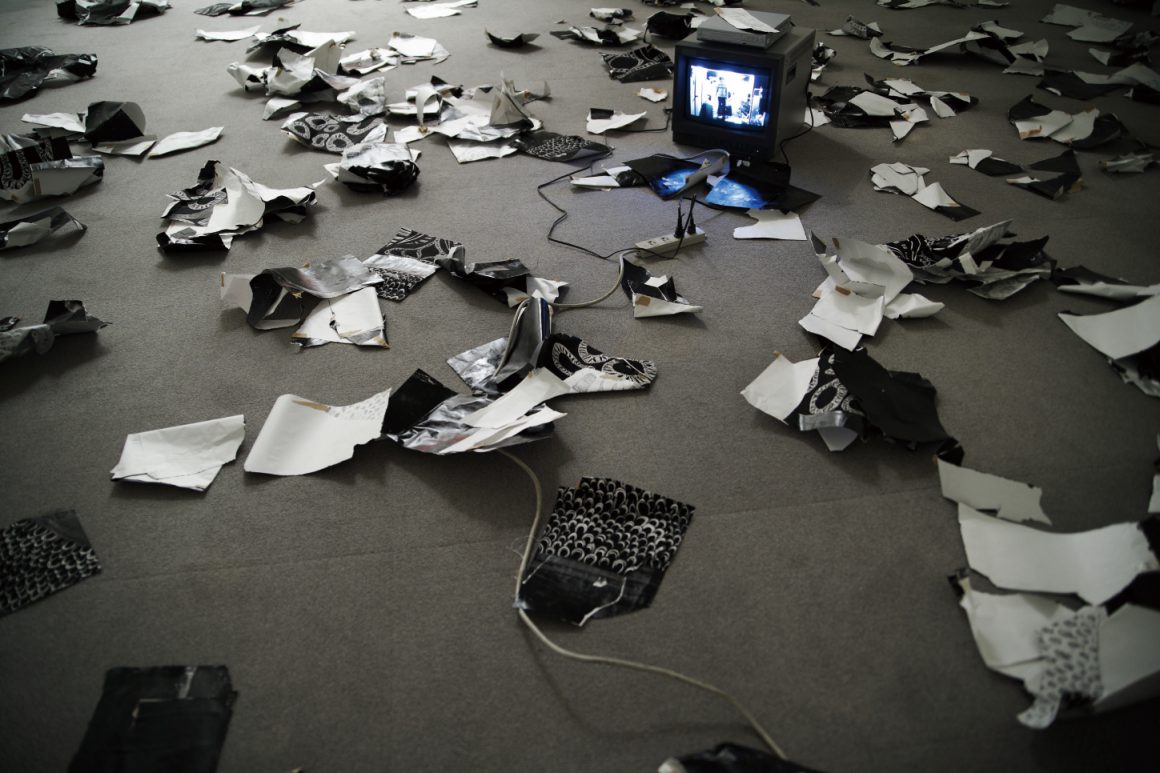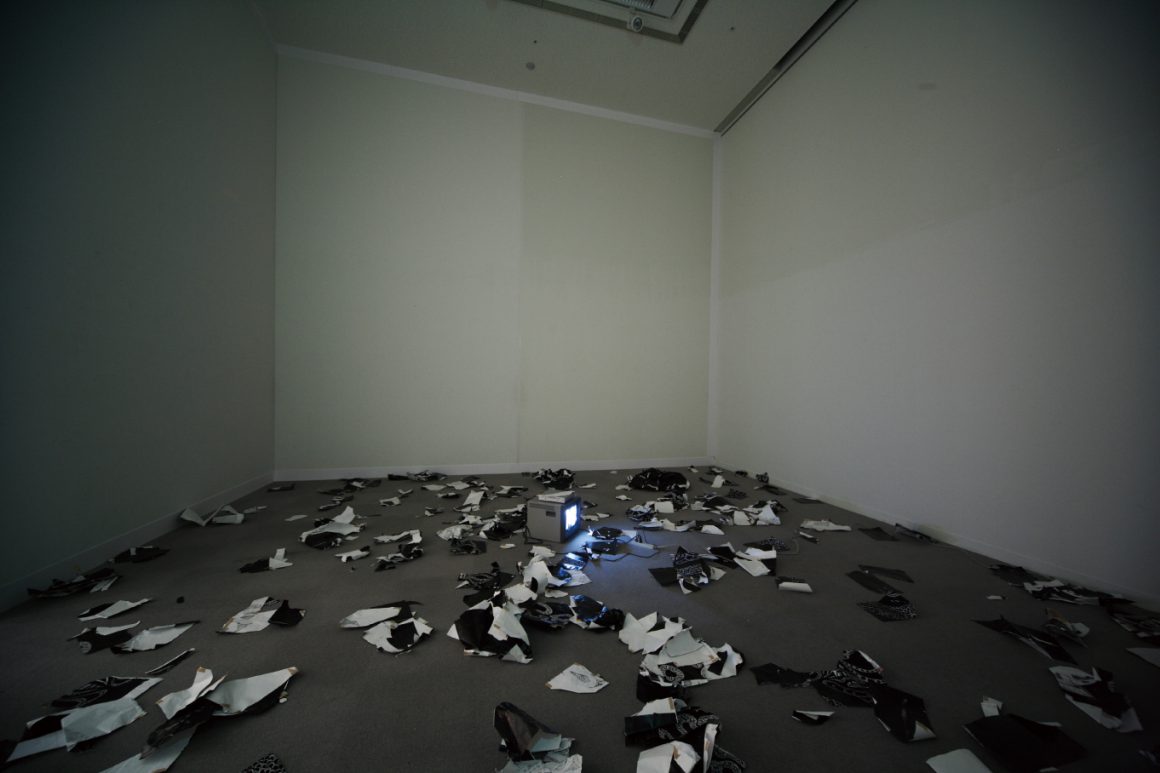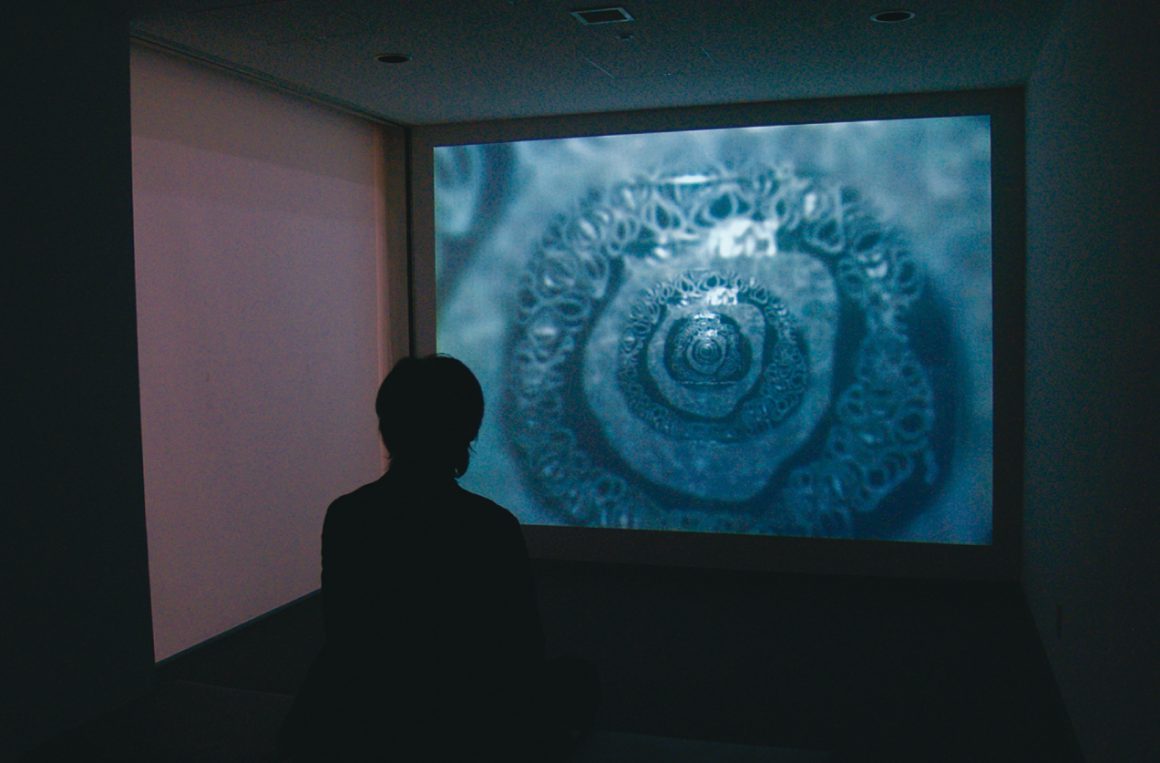
図1-1 澤崎賢一《日常としての表象+作品後》「ジーンズファクトリーアートアワード2008」での展示風景(佐藤篤撮影)
Fig. 1-1 Kenichi Sawazaki, a symbol as a daily life + after a piece of work, Jeans Factory Art Award 2008 (Photo by Atsushi Sato)
2. 主体性の消去と芸術の自律の不可能性
2. The disappearance of subjectivity and the impossibility of artistic autonomy
《日常としての表象+作品後》
まず、主体性をテーマに据えた作品に、2008年に株式会社インターナカツが主催する公募展「ジーンズファクトリーアートアワード」で発表された映像インスタレーション《日常としての表象+作品後[1]》がある。この作品を端的に言い表すならば、「積極的に主体性を消去」しようとしたものである。展示空間には、「ゴミ」のような紙の残骸が散らばっていて、映像モニターがポツンと中央に1台置いてある(図1-1, 図1-2)。《作品後》と名付けられたその映像作品には、小汚いアパートの一室で、ビリビリに破かれた紙の切れ端を棺桶のような箱の中に片付けている作家自身の姿が映っている(図1-3)。
a symbol as a daily life + after a piece of work
First of all, there is the video installation a symbol as a daily life + after a piece of work[1], which was presented at the Jeans Factory Art Award, an open call exhibition organized by Inter Nakatsu Co.,Ltd. in 2008. To put it simply, this work is an attempt to “actively erase subjectivity”. The exhibition space is littered with paper remnants that look like “trash”, and there is a single video monitor in the middle of the space (Fig. 1-1, Fig. 1-2). The video work, named after a piece of work, shows the artist himself in a dirty flat, cleaning up the torn pieces of paper in a coffin-like box (Fig. 1-3).

図1-2 澤崎賢一《日常としての表象+作品後》「ジーンズファクトリーアートアワード2008」での展示風景(佐藤篤撮影)
Fig. 1-2 Kenichi Sawazaki, a symbol as a daily life + after a piece of work, Jeans Factory Art Award 2008 (Photo by Atsushi Sato)

図1-3 澤崎賢一《作品後》より
Fig. 1-3 Kenichi Sawazaki, after a piece of work
この展示空間の裏側にはパーティションの格納庫があって、そこに別の映像作品《日常としての表象》(図1-4)を設置した。この作品は、作家が自室で「絵画のようなもの」を延々と描き続けて、そのまま部屋が真っ黒になるまでをビデオカメラで撮影し、編集の段階で逆回転にして早送りした映像である。このとき、描いた絵画のようなものをビリビリに破いて撒き散らしたのが、上記の展示風景である。ゆえに、この展示空間は、絵画のようなものの残骸、つまりは「ただのゴミ」が散らかっているという見立てになる。
この《日常としての表象》は、作家自身、つまり当時の僕が、外部との接触を絶ち、約3週間にわたって食事・トイレ・睡眠以外はひたすら自室で作業をし続け、その様子を24時間インターバルで撮影したものを8分ほどに圧縮した映像である(図1-5)。当時のモチベーションを振り返ると、「主体性の消失」を事前にかなり意識していたために、ある種の修行僧のように、一定以上の肉体的な負荷をかけ続ける中で、動物的に「ただ行為を重ねる」必要があったのである。
At the back of this exhibition space, there is a partitioned hangar, where I installed another video work, a symbol as a daily life (Fig. 1-4). In this work, the artist continued to paint “something like a painting” in his room, and filmed it with a video camera until the room turned black, and then reversed and fast-forwarded it during the editing stage. At this time, the painted “painting-like objects” were torn to pieces and scattered around the exhibition space as shown above. Therefore, this exhibition space can be seen as the remains of “something like a painting”, in other words, “just trash” scattered around.
This a symbol as a daily life is a video of the artist himself, i.e. me at that time, working in my room for about three weeks without any contact with the outside world, except for eating, going to the toilet and sleeping, which was filmed in 24-hour intervals and compressed into about eight minutes (Fig. 1-5). Looking back on my motivation at that time, I was quite conscious of the “disappearance of subjectivity” beforehand, and I had to “just do the deed” in an animalistic way, like some kind of ascetic monk, under a constant physical load.

図1-4《日常としての表象》の展示風景(筆者撮影)
Fig. 1-4 Kenichi Sawazaki, a symbol as a daily life (Photo by the author)

図1-5《日常としての表象》より
Fig. 1-5 Kenichi Sawazaki, a symbol as a daily life
しかし、なぜ「主体性の消失」をそんなに必死に追求する必要があったのだろうか。その根本にあったのが「芸術の自律」の不可能性であった。ヴァルター・ベンヤミン(1892-1940)が述べたように、複製技術の時代において、芸術が宗教的な信仰と結びついた「礼拝的価値」ではなく、そこから切り離された「展示的価値」へと転化したとき、「芸術の自律」が問題となる[2]が、近代以降の交通手段や印刷技術の発達、あるいは情報技術の台頭を経て、社会的なコンテクストから自律した芸術の実現はもはや不可能で、社会的なコンテクストとの関係性やその周縁に関心を向ける芸術表現が多く登場してきた。
例えば、フルクサスの創始者であるジョージ・マチューナス(1931-1978)は、1962年にフルクサスの活動を「芸術と生活の区別に対して、直接対抗するものだ」としている。つまり、半世紀以上前のこの時点で、既に「芸術の自律」は問題の中心にはなく、その周縁に位置づけられてきた人々の暮らしの方に関心は移っているのである。その後もギー・ドゥボール(1931-1994)の「シチュアシオニスト・インターナショナル[3]」やヨーゼフ・ボイス(1921-1986)の「社会彫刻[4]」など、政治に関わる芸術活動も多く現れた。にもかかわらず、僕は最初期の作品において、「芸術の自律」を問題の中心に据えた。その実現が不可能であればこそ、その不可能性を表象することに意義を感じた。そのためにこそ、「芸術の自律」と関係する「作家の主体性」を剥き出しの状態でごろんと提示させる必要があった。
その理論的な背景に、イタリアの哲学者ジョルジョ・アガンベン(1942-)が述べる「動物化」、人間であることの条件をぎりぎりまで削ぎ落とされ、単なる動物と化してしまった人間、これに芸術の可能性を賭けようと僕は意気込んだ。しかし、アガンベンがこの「動物化」について語るとき、彼が想定していたのは、アウシュヴィッツで惨殺されたユダヤ人の中で、同じユダヤ人にも非人間的扱いを受けたムーゼルマンと呼ばれるユダヤ人たちである[5]。彼らは、思考や感情などを削ぎ落とされ、ただただ作業に従事し続けていた。そこにどんな可能性があるというのか[6]。いま振り返ると甚だ疑問だが、本来信仰と結びついていた「アウラ」を、信仰からも社会的なコンテクストからも切り離されたところで生み出そうとする苦悩の極限ではある。
《日常としての表象》において、僕が試みたことは、ムーゼルマンよろしく、ただ1つの作業を誰とも関わることなく、自室でひとりしつこく機械的に実行したのであった。このとき、僕は精神的に通常とは異なる高揚状態で、目標としていた部屋が真っ黒になる直前直後、近所のコンビニに出かけるときですら、外部と関係する恐怖、あるいは身体の震えを感じたが、このような経験はあとにも先にもこのときだけである。人間が外部と関係を持ち続けなければ、自分自身として存在することすら危ういことになるのだと肉体的に思い知らされた瞬間である。
このとき僕にとって、撮影時に固定で設置されたカメラのまなざしの存在は大きかった。カメラのまなざし、つまりは外部からの目線を意識するからこそ、僕は修行僧のように「ただ行為を重ねる」ことができた。《日常としての表象》の撮影時のある種の究極的な状況においても、カメラは被写体と世界との「あいだ」で両者が関係し続けることを保証したのである。
しかし、作者の制作意図に関わらず、手紙は受け手に誤読されるものである。《日常としての表象》を見た者の感想の多くは、例えば、「眠っているとき意外と寝相が良いね」とか、「これ自宅のアパートなの?」とか、「パスタばかり食べていたの?」とか、「髪の毛が長いね」とか、そこに写り込んでいる男のとりとめもない日常生活に関するものがほとんどであった。本来ならば、無名の男の特に特徴のないアパートでの日常生活に多くの鑑賞者は関心を持つことなどないだろう。にもかかわらず、それを特定の手法によって表象しているからこそ、鑑賞者は暮らしの些細な細部に注意を向けることになった点は興味深かった。
これはいったいどうしてだろうか。端的に、それが芸術作品を展示する空間にあったため、内容如何にかかわらず、慣習的に鑑賞者は何かを読み解こうとしたのであろうか。その側面も否定できない。しかし、歴史的には、芸術作品のアウラは既に凋落している。映り込んでいるのは、ただ男が寝たり起きたりしているだけの映像となるが、それでもなお、そこには映像作品の時間の流れに生々しさが滲み出ていたからこそ、鑑賞者は映像の細部に関心を向けたのではないか、ということである。
—
[1] 澤崎賢一《日常としての表象+作品後》(高知市文化プラザかるぽーと, 高知, 2008)は、映像作品《日常としての表象》(DV, 8分23秒, 2007)と映像作品《作品後》(HD, 13分46秒, 2008)を組み合わせた映像インスタレーション作品である。
[2] ヴァルター・ベンヤミン(1999)『複製技術時代の芸術』佐々木基一編集・解説, 晶文社
[3] シチュアシオニスト・インターナショナルは、1950年代から70年代初頭にかけて、フランスを始めとしたヨーロッパ諸国において芸術・文化・社会・政治・日常生活の統一的な批判・実践を試みた前衛集団である。彼らは、大量消費やイメージの支配する既存の社会体制、都市計画等へ反発し、それらに支配されないまったく新しい欲望の形態を創出すべく、解放された生の瞬間を集団的かつ意図的に作り上げる、いわゆる「状況の構築」を目指した(現代美術用語辞典ver.2.0 – Artscape)。
[4] 「社会彫刻」はボイスの提唱した概念で、あらゆる人間は自らの創造性によって社会の幸福に寄与しうる、すなわち、誰でも未来に向けて社会を彫刻しうるし、しなければならない、という呼びかけである。それは、「芸術こそ進化にとっての唯一の可能性、世界の可能性を変える唯一の可能性」というボイスの信念から発している(現代美術用語辞典ver.2.0 – Artscape)。
[5] ジョルジョ・アガンベン(2001)『アウシュヴィッツの残りのもの―アルシーヴと証人』上村忠男・廣石正和訳, 月曜社
[6] 農業史を専門とする藤原辰史(1976-)が『分解の哲学 – 腐敗と発酵をめぐる思考』(2019)の中で、「ある志向性を持って構築された構成物からあらゆる機能と付随物を剥ぎ取っていくという分解現象」がアガンベンの「裸姓」のたわむれとして欠かせないと述べている。「動物化」と「裸姓」は通ずる概念だが、これらを藤原の言う「分解」と結びつけた議論は興味深い(p.36)。
But why was it necessary to pursue so desperately the “disappearance of subjectivity”? At the root of this was the impossibility of “artistic autonomy”. As Walter Benjamin (1892-1940) put it, “the autonomy of art” becomes a problem when, in the age of reproduction technology, art is no longer the “cult value” linked to religious beliefs, but the “exhibition value” detached from them[2]. However, with the development of transportation and printing technologies since the modern era, and the rise of information technology, it is no longer possible to realize art that is autonomous from its social context, and many artistic expressions have emerged that are concerned with the relationship with the social context and its periphery.
For example, George Matunas (1931-1978), the founder of Fluxus, described the work of Fluxus in 1962 as “a direct opposition to the distinction between art and life”. At this point, more than half a century ago, the autonomy of art was no longer at the centre of the question, and the focus had shifted to the lives of those who lived on the margins. Since then, many politically engaged artistic activities have appeared, such as Guy Debord’s (1931-1994) Situationist International[3] and Joseph Beuys’ (1921-1986) Social Sculpture[4]. In spite of this, in my first works I placed the autonomy of art at the centre of the problem. It is precisely because it is impossible to achieve this that I felt it significant to represent its impossibility. For this reason, it was necessary to present the “subjectivity of the artist” in relation to the “autonomy of art” in a bare state.
Against this theoretical background, I was determined to bet on the possibility of art being “animalised”, as the Italian philosopher Giorgio Agamben (1942-) describes it: a human being who has been reduced to a mere animal, with all the conditions of humanity stripped away. But when Agamben speaks of this ‘animalisation’, he is referring to the Jews who were slaughtered at Auschwitz, the so-called Musselmans, who were also dehumanised by the Jews[5]. They were stripped of their thoughts, feelings, etc., and just kept on working. What possibilities were there for them[6]? In retrospect, it is highly questionable, but it is the extreme limit of the struggle to create an “aura” that was originally linked to faith, but which was separated from faith and from its social context.
In a symbol as a daily life, I attempted, like Mooselman, to carry out a single task mechanically and persistently, alone in my room, without getting involved with anyone. I was in an unusual state of mental exaltation, and even when I went out to the local convenience store, just before my target room turned black, I felt the fear of being in relation to the outside world, or even the trembling of my body, but this was the only experience I have ever had. This is the only time I have ever had such an experience. It was a physical reminder that if we don’t stay in relation with the outside world, we are in danger of not even existing as ourselves.
The presence of the camera’s gaze, fixed at the time of filming, was crucial for me at this moment. Being aware of the camera’s gaze, that is to say, of the eyes from the outside, made it possible for me to “just do the act” like a monk. Even in the kind of ultimate situation in which I shot a symbol as a daily life, the camera ensured that the relationship between the subject and the world continued “between” the two.
However, regardless of the artist’s intentions, the letters are misinterpreted by the recipients. Many of the comments made by viewers of a symbol as a daily life are, for example, “You sleep surprisingly well when you are asleep”, “Is this your flat? or “Have you been eating only pasta? or “You have long hair”, and so on, mostly about the trivial daily life of the men in the photos. Normally, most viewers would not be interested in the daily life of an unknown man in an unremarkable flat. Nevertheless, it is interesting to note that the particular way in which it is represented draws the viewer’s attention to the minutest details of life.
Why is this so? Is it simply that, because it was in a space where works of art were displayed, viewers were conventionally inclined to read something into them, regardless of their content? That aspect cannot be denied. Historically, however, the aura of the work of art has already fallen. What we see in the image will be just a man sleeping and waking up, but nevertheless, there was a vividness in the flow of time in the work of art, and that is why the viewers were interested in the details of the image.
[1] Kenichi Sawasaki, a symbol as a daily life + after a piece of work, (Kochi City Cultural Plaza Karuport, Kochi, 2008) is a video installation work combining the video work a symbol as a daily life (DV, 8min 23sec, 2007) and the video work after a piece of work (HD, 13min 46sec, 2008).
[2] Walter Benjamin (1999), The work of art in the age of mechanical reproduction, edited and commented by Kiichi Sasaki, Shobunsha
[3] From the 1950s to the early 1970s, the Situationists International was an avant-garde group that attempted a unified critique and practice of art, culture, society, politics and everyday life in France and other European countries. They rebelled against the existing system of mass consumption and the dominance of images, urban planning, etc., and aimed to collectively and deliberately create moments of liberated life, so-called “construction of situations”, in order to create completely new forms of desire that were not governed by them(Dictionary of Contemporary Art ver.2.0 – Artscape).
[4] “Social Sculpture” is a concept proposed by Beuys, which calls for every human being to contribute to the well-being of society through his or her creativity, that is, everyone can and must sculpt society for the future. It stems from Beuys’ belief that “art is the only possibility for evolution, the only possibility for changing the possibilities of the world”. (Dictionary of Contemporary Art ver.2.0 – Artscape).
[5] Giorgio Agamben (2001), Remnants of Auschwitz: The Witness and the Archive, translated by Tadao Uemura and Masakazu Hiroishi, published by Getsuyosha.
[6] Tatsushi Fujiwara (1976-), a specialist in agricultural history, in his book Philosophy of Decomposition: Thoughts on Decomposition and Fermentation (2019), states that “the phenomenon of decomposition, the stripping away of all functions and concomitants from a construct constructed with a certain orientation” is essential to Agamben’s flirtation with “nakedness”. Animalization” and “nakedness” are related concepts, but it is interesting to see how he links them to what Fujiwara calls “decomposition” (p.36).